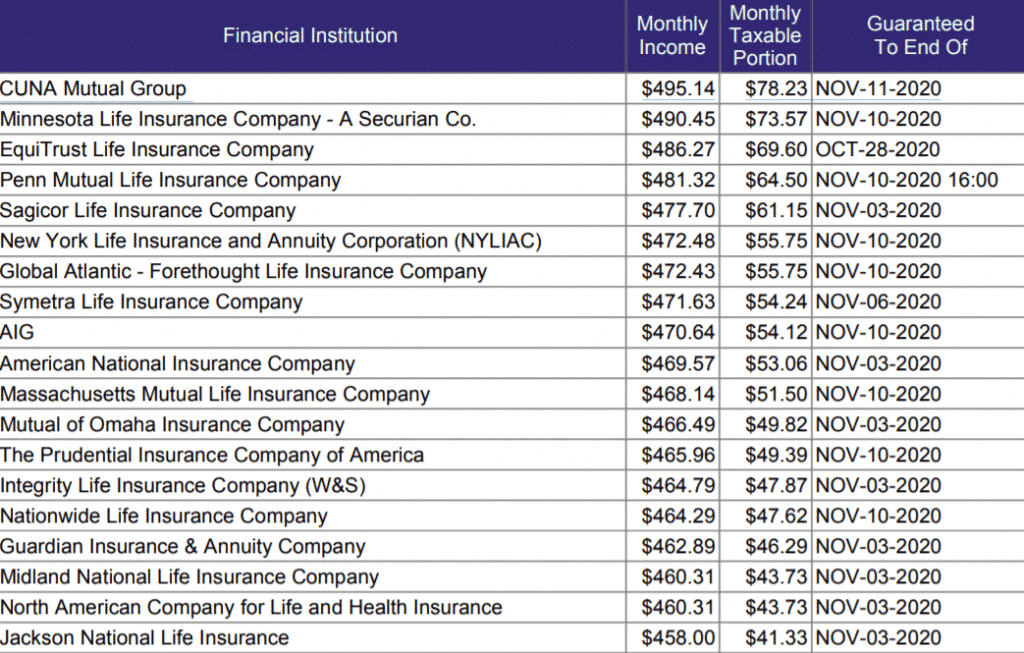Annuity Rates: Embark on a journey to unravel the intricacies of retirement planning. Understanding these rates is paramount for ensuring a secure and fulfilling post-work life. Join us as we delve into the factors that shape annuity rates, explore the various types available, and uncover strategies for optimizing your retirement income.
From historical trends to market influences, we will meticulously analyze the dynamics of annuity rates, empowering you with the knowledge to make informed decisions about your financial future.
Annuity Rate Trends: Annuity Rates

Annuity rates have fluctuated over time, influenced by various economic factors. Historically, rates have been relatively stable but have experienced periods of decline during economic downturns.
Factors Influencing Annuity Rates
Several factors influence annuity rates, including:
- Interest rates: Annuity rates are typically tied to interest rates, with higher interest rates leading to higher annuity rates.
- Life expectancy: As life expectancy increases, annuity rates tend to decrease because insurance companies must pay out benefits over a longer period.
- Inflation: Inflation can erode the purchasing power of annuity payments, so annuity rates may increase to offset the effects of inflation.
- Competition: Competition among insurance companies can also affect annuity rates, with companies offering higher rates to attract customers.
Current Annuity Rates
Current annuity rates vary depending on the insurance company, the type of annuity, and the individual’s age and health. The following table provides a snapshot of current annuity rates from leading insurance companies:
| Insurance Company | Immediate Annuity | Deferred Annuity |
|---|---|---|
| Company A | 4.5% | 3.8% |
| Company B | 4.2% | 3.6% |
| Company C | 4.8% | 4.0% |
Factors Affecting Annuity Rates
Annuity rates are influenced by various factors, including interest rates, inflation, and life expectancy. Market conditions and economic policies also play a role in determining these rates.
Interest Rates
Interest rates are a major factor affecting annuity rates. Higher interest rates generally lead to higher annuity rates, as insurance companies can invest the premiums they receive at higher rates and earn more income. Conversely, lower interest rates can result in lower annuity rates.
Inflation, Annuity Rates
Inflation is another important factor that affects annuity rates. Higher inflation erodes the purchasing power of future payments, making it necessary for insurance companies to increase annuity rates to ensure that annuitants receive a sufficient income.
Life Expectancy
Life expectancy is a key factor in determining annuity rates. The longer the life expectancy of annuitants, the lower the annuity rates will be, as insurance companies need to spread the payments over a longer period. Conversely, shorter life expectancies lead to higher annuity rates.
Market Conditions
Market conditions can also affect annuity rates. In periods of economic uncertainty, investors may seek the safety of annuities, leading to higher demand and potentially higher annuity rates. Conversely, in periods of economic growth, investors may prefer other investment options, leading to lower demand and potentially lower annuity rates.
Economic Policies
Economic policies, such as quantitative easing or interest rate hikes, can also impact annuity rates. These policies can affect the overall investment environment and the availability of funds for insurance companies, which can in turn affect annuity rates.
Types of Annuities and Their Rates
Annuities are financial products that provide a steady stream of income for a specific period or the lifetime of the annuitant. Different types of annuities offer varying rates and features, catering to different financial needs and goals.
Fixed Annuities
Fixed annuities offer a guaranteed interest rate for a specified period, providing a predictable income stream. The rates for fixed annuities are typically lower than those of other annuity types, but they offer stability and protection against market fluctuations.
Variable Annuities
Variable annuities offer the potential for higher returns as they are linked to the performance of underlying investments. However, they also carry investment risk, and the income stream can fluctuate based on market conditions. The rates for variable annuities are tied to the performance of the underlying investments and may vary over time.
Immediate Annuities
Immediate annuities provide an immediate stream of income upon purchase. The rates for immediate annuities are generally higher than those of other annuity types, but they do not offer the potential for growth. The income stream is guaranteed for the lifetime of the annuitant or for a specified period.
| Type | Rate Type | Investment Risk | Income Stream |
|---|---|---|---|
| Fixed | Guaranteed | Low | Predictable |
| Variable | Market-linked | High | Fluctuating |
| Immediate | Guaranteed | Low | Immediate and guaranteed |
Final Conclusion
In the tapestry of retirement planning, annuity rates serve as the threads that weave together a secure financial future. By comprehending the factors that influence these rates and the nuances of different annuity types, you can tailor your retirement strategy to align with your unique needs and aspirations.
Remember, the path to a worry-free retirement begins with a thorough understanding of annuity rates. Embrace this knowledge and embark on a journey towards financial well-being in your golden years.
FAQs
What are the key factors that affect annuity rates?
Interest rates, inflation, life expectancy, market conditions, and economic policies are the primary factors that shape annuity rates.
How do I choose the right annuity type for my needs?
Consider your risk tolerance, investment goals, and income needs when selecting an annuity type. Fixed annuities provide a guaranteed income stream, while variable annuities offer the potential for higher returns but with more risk.
Can I withdraw money from my annuity before the maturity date?
Depending on the type of annuity, early withdrawals may be subject to surrender charges or penalties. It’s important to consult with a financial advisor to understand the terms and conditions of your annuity contract.